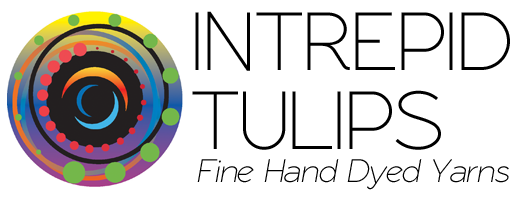Variegated yarn driven projects cry out for some thought in the post-purchase, pre-cast on phase. In the last WVYC post, I wrote about looking at a skein of variegated yarn and thinking about the implications of it’s design. (I don’t know about you, but the ooohing, the aaahing, and the purchasing don’t necessarily involve thinking.)
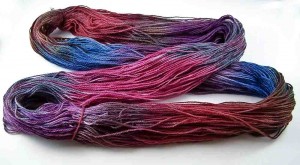
Here again is the yarn under consideration.
To recap: since each color section is short, it shouldn’t stripe badly when knit, and I shouldn’t need drastic measures to generate a fabric that I like. I bet I’ll like a basic seed stitch, but because blogs are more interesting with pictures, and because, if I knit enough swatches, you may not have to, I put this yarn through the process.
Swatches
I know that swatching – the decision to knit and action of knitting a wee scrap of fabric that in no way physically pertains to the finished project – could provide material for an entire eye-roller of a blog monologue. I will just say here that as the modifications I make to patterns grow increasingly dramatic, and the more I play with variegated yarns, the more impressed I am with the quantity and value of the information I can glean from a wee swatch.
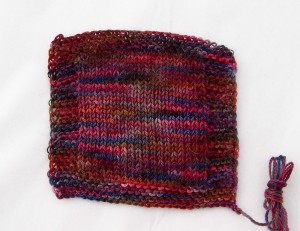
Here are two swatches. Actually, front and back of the same swatch, proving that there are some free lunches to be had in swatching. I like them both; in stockinette you are bound to get stripes from a variegated yarn. The only mystery will be the length of the stripe. As we suspected when looking at the skein, these stripes aren’t too long.
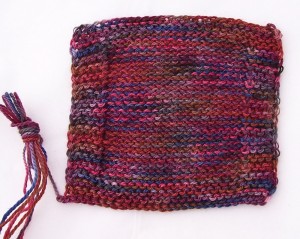
Reverse stockinette breaks up the stripes because the interlinking of the rows, or columns, of stitches is made visible.
Seed stitch takes this idea even further. My seed stitch “swatch” is the collar of a top-down sweater. (Don’t we all sometimes swatch on 100+ stitches??!?) The top third of the photo shows straight, by the book, seed stitch: K1, P1.
The bottom two thirds (below the green dots) show a more interpretive version of seed stitch. I wanted a bit more texture and less uniformity, so I tried purling all the blue stitches. There was nothing magical or inspired about my choice of blue; it seemed that I be most likely to notice when either the blue stitches or the pink ones came up. This approach creates short, randomly placed ridges that break up the surface. Depending on you feel about randomness and having to watch your stitches as you knit, this can be a fun option.
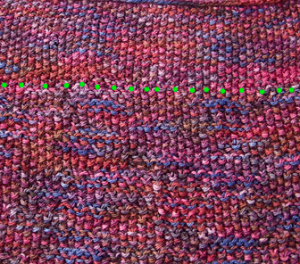
Patterns for Variegated Yarn
With the swatch data gathered, and a fabric chosen, I knew I wanted a simple garment pattern. Whenever you’re trying to show off a nifty yarn, it makes sense to go with a simple pattern that won’t be distracting. I headed over to Ravelry, and after nosing around in their huge pattern database, I found this simple, elegant little sweater by Cecily Glowik MacDonald, called Breakwater. As you can see, it was worked in stockinette stitch in a variegated yarn for the pattern publication. My gauge matched pretty closely in seed stitch, so on I cast and off I knit!

